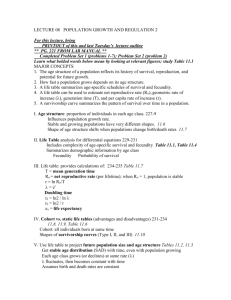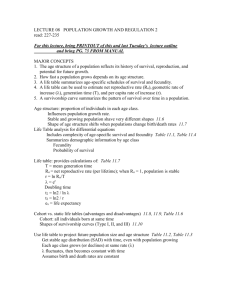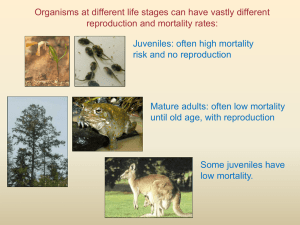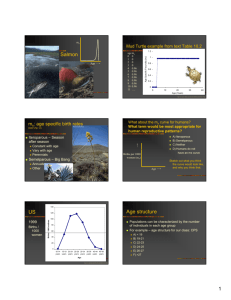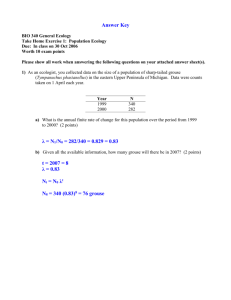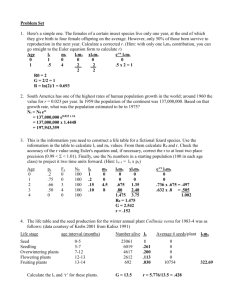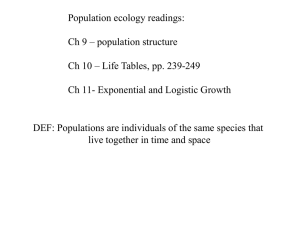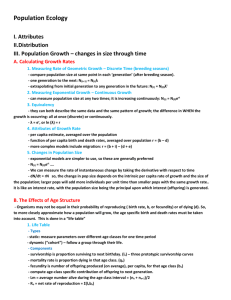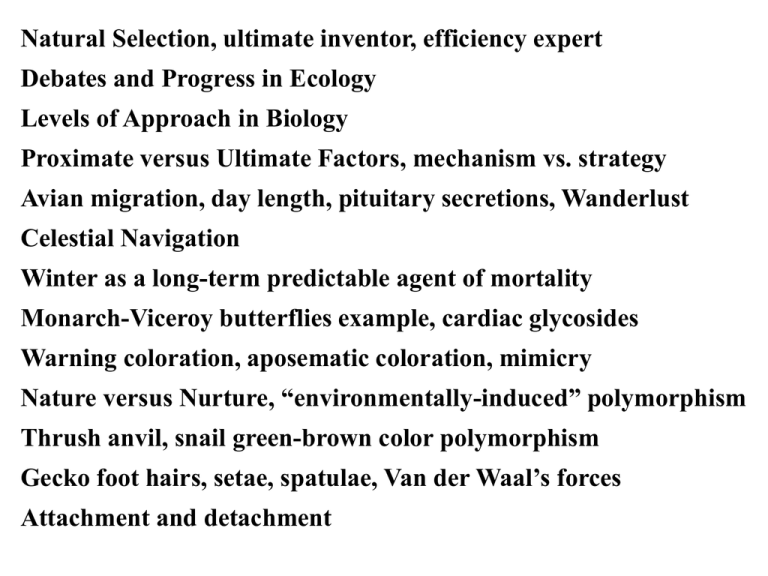
Natural Selection, ultimate inventor, efficiency expert
Debates and Progress in Ecology
Levels of Approach in Biology
Proximate versus Ultimate Factors, mechanism vs. strategy
Avian migration, day length, pituitary secretions, Wanderlust
Celestial Navigation
Winter as a long-term predictable agent of mortality
Monarch-Viceroy butterflies example, cardiac glycosides
Warning coloration, aposematic coloration, mimicry
Nature versus Nurture, “environmentally-induced” polymorphism
Thrush anvil, snail green-brown color polymorphism
Gecko foot hairs, setae, spatulae, Van der Waal’s forces
Attachment and detachment
Figure 8.1
Quick Time™ a nd a
d eco mp res so r
ar e n eed ed to s ee this pic tur e.
Figure 8.1
Testosterone
Figure 8.1
Testosterone
Figure 8.1
Vital Statistics of Populations
Deme (Mendelian Population)
Demography (assume all individuals equal)
Population Parameters (emergent properties)
Mean and Variance
Individual
Population
Male or Female
Sex Ratio
Has Babies or not
Birth Rates
Alive or Dead
Death Rates
Given Age
Age Structure
Fixed Genotype
Gene Frequencies
Growth Rates
Density
Life tables: Horizontal versus vertical samples
Segment
Cohort
Birth
Time
Figure 8.2
Figure 8.3
Life Tables
Discrete versus Continuous Ages
Pivotal Age assumption (age classes)
qx = force of mortality (fraction dying during age interval)
qx = age-specific death rate
Survivorship curves
lx = fraction of initial cohort that survives to age x
ly / lx = probability of living from age x to age y
Ex = Expectation of further life
Type 1: Rectangular
Type 2: Diagonal
Type 3: Inverse Hyperbolic
Xantusia vigilis
sheep
Uta stansburiana
Figure 8.4
Quic kT ime™ and a
dec ompress or
are needed to s ee this pi cture.
Xantusia vigilis
Eumeces
fasciatus
Eumeces
fasciatus
Sceloporus olivaceus
Palm tree Euterpe globosa
Figure 8.5
Fecundity, Tables of Reproduction
mx = age-specific fecundity
Two conventions: females only, or count both
males and females but weight each as one-half
(only progeny entering age class zero are counted)
Gross reproductive rate (GRR) is the sum of mx over all ages
However, because some females will die before having all
their possible babies, must calculate realized fecundity which
is simply lxmx (the fraction of females surviving times their fecundity)
Realized fecundity, lxmx, is summed over all ages to get the
Net Reproductive Rate, R0 (also called the Replacement Rate
of the Population)
http://www.zo.utexas.edu/courses/THOC/breeders.html
http://www.oregonlive.com/kiddo/index.ssf/2008/05/environmental_moms_stop_at_one.html
http://www.zo.utexas.edu/courses/THOC/breeders.html
http://www.oregonlive.com/kiddo/index.ssf/2008/05/environmental_moms_stop_at_one.html
The Romneys
2 ——> 20
2 ——> 20
20 x 20 = 400
2 ——> 20
20 x 20 = 400
400 x 20 = 8,000
2 ——> 20
Exponential
20 x 20 = 400
Population
400 x 20 = 8,000
8,000 x 20 = 160,000
Growth!
2 ——> 20
Exponential
20 x 20 = 400
Population
400 x 20 = 8,000
8,000 x 20 = 160,000
Growth!
2 ——> 20
Exponential
20 x 20 = 400
Population
400 x 20 = 8,000
Growth!
(Home of Duggers and Romneys)
8,000 x 20 = 160,000
Pediculus humanus
Figure 8.6
Deme, demography, vital statistics of populations
Population parameters, mean and variance
“Life” Tables: Cohort vs. Segment Samples
Age and sex specificity
Homocide example: Chicago vs. England
Numbers dying in each age interval
Discrete vs. continuous approaches
Force of Mortality qx
Age-specific survivorship lx
Type I, II, III survivorship
(rectangular, diagonal, inverse hyperbolic)
Expectation of further life,
Age-specific fecundy, mx
Age of first reproduction, alpha, — menarche
Age of last reproduction, omega,
Realized fecundity at age x, lxmx
Net Reproductive rate
Human body louse, R0 = 31
Generation Time, T = xlxmx
Reproductive value, vx
Stable vs. changing populations
Residual reproductive value
T, Generation time = average time from one generation to the next (average time from egg to egg)
vx = Reproductive Value = Age-specific expectation
of all future offspring
p.143, right hand equation (4)
“dx” should be “dt”
In populations that are expanding or contracting, reproductive
value is more complicated. Must weight progeny produced
earlier as being worth more in expanding populations, but worth
less in declining populations. The verbal definition is also
changed to “the present value of all future offspring”
QuickTime™ and a
decompressor
are needed to see this picture.
p.146, left hand
equation (5) left
out e-rt term
vx = mx + (lt / lx ) mt
Residual reproductive value =
age-specific expectation of offspring in distant future
vx* = (lx+1 / lx ) vx+1
Intrinsic rate of increase (per capita, instantaneous)
r=b-d
rmax and ractual — lx varies inversely with mx
Stable (stationary) age distributions
Leslie Matrices (Projection Matrix)
Dominant Eigenvalue = Finite rate of increase
Illustration of Calculation of E , T, R , and v in a Stable Population with Discrete Age Classes
x
0
x
_____________________________________________________________________
Age
Expectation Reproductive
Weighted
of Life
Value
SurvivorRealized
by Realized Ex
vx
Age (x)
ship
Fecundity Fecundity Fecundity
lx
mx
lxmx
x lxmx
_____________________________________________________________________
0
1.0
0.0
0.00
0.00
3.40
1.00
1
0.8
0.2
0.16
0.16
3.00
1.25
2
0.6
0.3
0.18
0.36
2.67
1.40
3
0.4
1.0
0.40
1.20
2.50
1.65
4
0.4
0.6
0.24
0.96
1.50
0.65
5
0.2
0.1
0.02
0.10
1.00
0.10
6
0.0
0.0
0.00
0.00
0.00
0.00
Sums
2.2 (GRR)
1.00 (R0) 2.78 (T)
_____________________________________________________________________
E0 = (l0 + l1 + l2 + l3 + l4 + l5)/l0 = (1.0 + 0.8 + 0.6 + 0.4 + 0.4 + 0.2) / 1.0 = 3.4 / 1.0
E1 = (l1 + l2 + l3 + l4 + l5)/l1 = (0.8 + 0.6 + 0.4 + 0.4 + 0.2) / 0.8 = 2.4 / 0.8 = 3.0
E2 = (l2 + l3 + l4 + l5)/l2 = (0.6 + 0.4 + 0.4 + 0.2) / 0.6 = 1.6 / 0.6 = 2.67
E3 = (l3 + l4 + l5)/l3 = (error: extra terms) 0.4 + 0.4 + 0.2) /0.4 = 1.0 / 0.4 = 2.5
E4 = (l4 + l5)/l4 = (error: extra terms) 0.4 + 0.2) /0.4 = 0.6 / 0.4 = 1.5
E5 = (l5) /l5 = 0.2 /0.2 = 1.0
v1 = (l1/l1)m1+(l2/l1)m2+(l3/l1)m3+(l4/l1)m4+(l5/l1)m5 = 0.2+0.225+0.50+0.3+0.025 = 1.25
v2 = (l2/l2)m2 + (l3/l2)m3 + (l4/l2)m4 + (l5/l2)m5 = 0.30+0.67+0.40+ 0.03 = 1.40
v3 = (l3/l3)m3 + (l4/l3)m4 + (l5/l3)m5 = 1.0 + 0.6 + 0.05 = 1.65
v4 = (l4/l4)m4 + (l5/l4)m5 = 0.60 + 0.05 = 0.65
v5 = (l5/l5)m5 = 0.1
Table 8.1
p. 144 delete
extra terms (red)
___________________________________________________________________________
QuickTime™ and a
decompressor
are needed to see this picture.
QuickTime™ and a
decompressor
are needed to see this picture.
Figure 8.7
Figure 8.7

